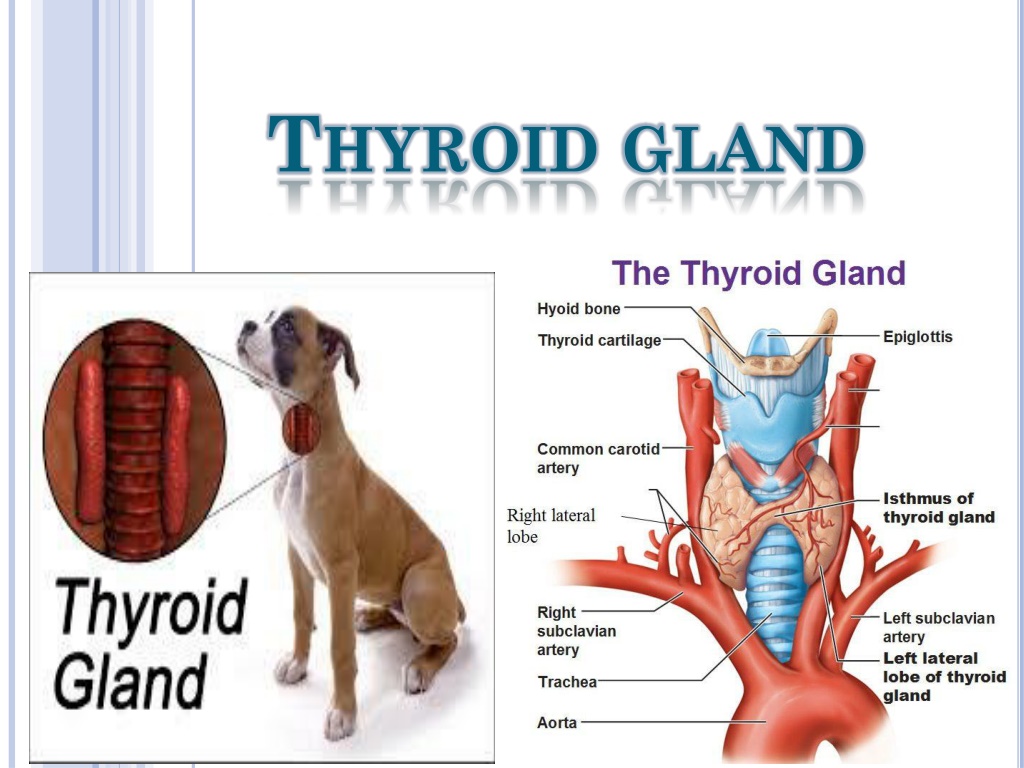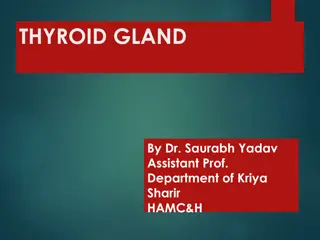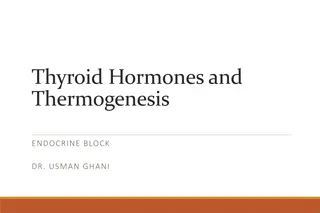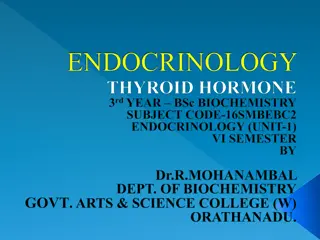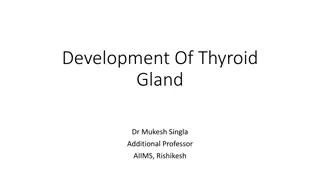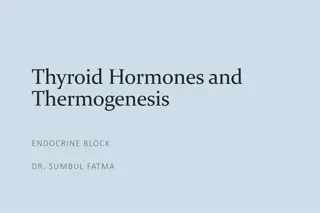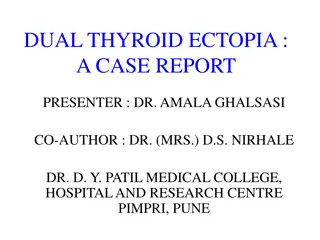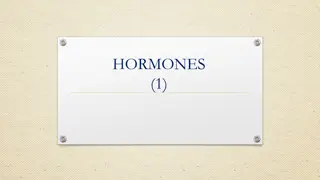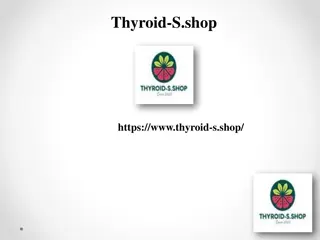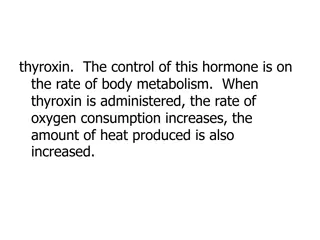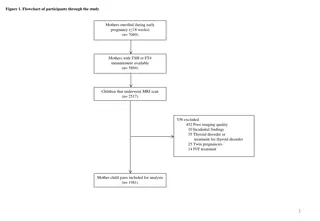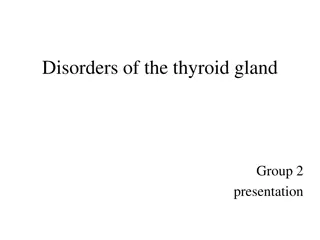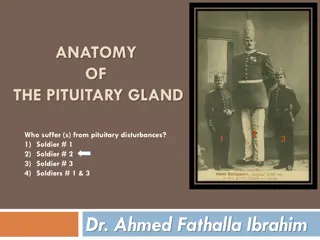Understanding the Thyroid Gland: Structure, Hormones, and Function
The thyroid gland, a butterfly-shaped structure located on the ventral surface of the trachea, secretes hormones essential for regulating metabolic rate, growth, and development. It produces hormones like Tetraiodothyronine T4, Triiodothyronine T3, and Calcitonin, which play crucial roles in maintaining physiological balance. The synthesis and secretion of thyroid hormones involve complex processes within follicular cells and the colloid. Understanding these processes sheds light on the importance of the thyroid gland in overall health and well-being.
Download Presentation

Please find below an Image/Link to download the presentation.
The content on the website is provided AS IS for your information and personal use only. It may not be sold, licensed, or shared on other websites without obtaining consent from the author. Download presentation by click this link. If you encounter any issues during the download, it is possible that the publisher has removed the file from their server.
E N D
Presentation Transcript
THYROID GLAND Is a butterfly shaped structure located on the ventral surface of trachea . His secreted 2 hormones : 1) Tetraiodothyronine T4, 2) Triiodthyronine T3 .and 3) Calcitonin .
THYROID GLAND The thyroid hormones regulate the body's metabolic rate and are necessary for normal growth and development . Calcitonin regulates Ca level in the blood . Thyroid hormones required for the synthesis of growth h. and genera permissive for its action , and it is also required foe GH to exert its effects on target tissue .
THYROID GLAND SYNTHESIS AND SECRETION OF THYROID H. The thyroid gland contains numerous spherical follicles each of which is compose of a single layer of secretory cells , called follicular cells , surrounding a glycoprotein the follicular cells secrete called colloid. TH hormones are synthesized in the follicles . C cells : are located in the interstitial space between the follicles , which is synthesize and secrete calcitonin .
THYROID GLAND SYNTHESIS AND SECRETION OF THYROID H. Thyroglobulin TG: The primary substance found in the colloid , is protein that function as the precursor molecule for thyroid H. Also located in the colloid are the enzymes required for thyroid H. synthesis and iodide (ionized form of iodine ) . The thyroglobulin and enzymes are synthesized in the follicular cells and secreted into the colloid by exocytosis. All component of thyroid H. synthesis located in the colloid .
THYROID GLAND STEPS OF THYROID H. SYNTHESIS AND SECRETION 1) 1) Tyrosine + thyroglobulin = iodinated 2) Iodinated + iodide = monoiodotyrosine (MIT) (MIT)+ second iodide =diiodotyrosine(DIT) 3) 2) Two iodinated tyrosine MIT &DIT on the same TG are coupled at which time the 2 tyrosine are linked together by covalent bond T4 &T3 are the thyroid H. , although at this step they are still attached to TG
THYROID GLAND STEPS OF THYROID H. SYNTHESIS AND SECRETION 3) Thyroid H. are stored in the colloid bound to TG for up to 3 months until release . 4) TSH arriving via the blood stream stimulates release of thyroid H. TSH bind to the receptors on the membrane of follicular cells , activated by cAMP second messenger system
THYROID GLAND STEPS OF THYROID H. SYNTHESIS AND SECRETION 5) The follicular cells taken iodinated TG molecules from the colloid by phagocytosis . 6) The phagosome containing the iodinated TG fuses with the lysosome . 7) Exposure of the TG molecule to lysosomal enzymes that break down the TG causes the release of T3&T4 into the follicular cells .
THYROID GLAND STEPS OF THYROID H. SYNTHESIS AND SECRETION 8) Because T3 & T4 are lipophilic , they can diffuses across the plasma membrane and into the blood stream , where they are: Selectively bound by protein carriers that include thyroxin binding globulin and transthyrethin and Non selectively bound by albumin .
THYROID GLAND STEPS OF THYROID H. SYNTHESIS AND SECRETION T4 is normally produced and secreted at a rate about 10 times greater than T3 . T3 is approximately 4 times more potent at the target tissues . Most of the T4 that is secreted into the plasma is eventually converted by the liver , kidneys or target tissue to the more active T3. In fact the majority of T3 in the plasma is synthesized from circulating T4 conversion of T4 to T3 is called activation .
THYROID GLAND STEPS OF THYROID H. SYNTHESIS AND SECRETION TH levels are virtually constant under normal condition because the primary control of its secretion occur via negative feedback . TH secretion is stimulated by TSH from the anterior pituitary gland
THYROID GLAND ACTION OF THYROID HORMONES Thyroid H. Are lipophilic and thus easily cross membrane , and receptors' for thyroid H. are in the nuclei of target cells . Binding of thyroid hormones to receptors alters the rate of transcription of mRNA from DNA . the primary action of the thyroid hormones is to raise the body basal metabolism rate that is increase the rate of O2 consumption and energy expenditure at rest .
THYROID GLAND ACTION OF THYROID HORMONES Thyroid H. stimulated increase in metabolism occur in most (but not all) tissue of the body . Notable exception are brain , spleen , and gonads. One way in which TH . increase metabolism is an increase in the rate of Na/K pump actively in cells .
THYROID GLAND ACTION OF THYROID HORMONES As ATP is hydrolyzed during activity of Na/K pump, hear is liberated ATP is used up, necessitating higher rates of fuel oxidation & ATP production which generate even more heat. Thyroid hormones also promote increased numbers of mitochondria in cells in concentration of certain enzymes involved in oxidation phosphorylation.
THYROID GLAND ACTION OF THYROID HORMONES Thyroid hormones also promotes increased energy mobilization when present in higher than normal concentration by promoting glycogenolysis, conversion of muscle protein to amino acids, and lipolysis. They also promote gluconeogenesis and ketone synthesis Conversely, at lower than normal concentration, thyroid hormones have opposite effect, promoting glycogenesis and protein synthesis.
THYROID GLAND ACTION OF THYROID HORMONES Thyroid hormones promote the synthesis of beta adrenergic receptors. Adrenergic receptors bind epinephrine & norepinephrine, the chemical messenger of sympathetic nervous system. Thyroid hormones permit many tissues to respond to sympathetic neural input and to circulatory epinephrine
THYROID GLAND ACTION OF THYROID HORMONES Thyroid hormones are necessary for normal growth and development of many tissues, and for maintaining normal function after growth has ceased. Many of these effects are mediated through stimulation of GH release ( in synergism with glucocorticoids) and permissiveness to GH in target tissues. Infants, thyroid hormone deficiency can lead to form of irreversible brain damage called cretinism, in which mental development is retarded and growth is stunted.
THYROID GLAND ACTION OF THYROID HORMONES In cretinism, axons and dendrites nerve cells are poorly developed and myelination of axons is defective Cretinism can be prevented by early diagnosis of hypothyroidism and initiation of T3 replacement therapy. In adult, thyroid hormone deficiency lead to impairment of mental function but defects are fully reversible upon restoration of normal thyroid hormone level.
stress Cold tempreture alter hypothalamus TRH secretion Anterior pituitary gland TSH secretion Thyroid gland
Thyroid gland T3 secretion n T4 secretion Plasma T3 Conversion T3 Many tissue Nervous system Primit normal growth and development Basal metabolic rate Heat production Respiratory rate Sympathetic output Permits maintenance of normal activity
